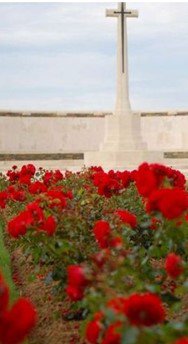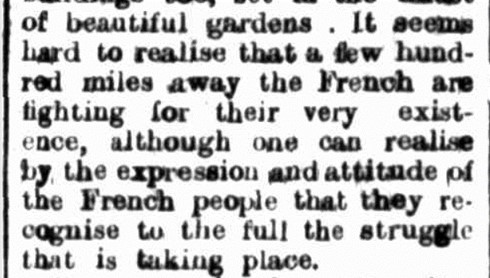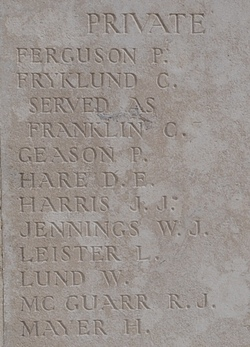Charles Magnus FRANKLIN
Eyes blue, Hair brown, Complexion fresh
Charles Franklin – Not Your Typical Australian Soldier
Can you help us identify Charles/Karl?
Charles was killed in Action at Fromelles. As part of the 55th Battalion he was positioned near where the Germans collected soldiers who were later buried at Pheasant Wood. There is a chance he might be identified, but we need help.
In 2008 a mass grave was found at Fromelles, a grave the Germans dug for 250 (Australian) bodies they recovered after the battle. As of 2024, 180 of these soldiers have been able to be identified via DNA testing. We are still searching for suitable family DNA donors for Charles.
If you know anything of contacts for Charles here in Australia or his relatives from the USA, Sweden or Finland, please contact the Fromelles Association.
See the DNA box at the end of the story for what we do know about his family.
Early Life
Charles Franklin’s background is not that of a ‘typical’ Australian soldier’s. His birth name was Karl Magnus Fryklund and he was born on 31 July 1888 in Hudiskval, Gauleborg Sweden. He was the third of Emma (nee Kangas) and Magnus Fryklund’s children:
- Walfred Emmanuel (1986-1963)
- Hulda Maria (1887-1985)
- Karl (Charles) Magnus (1888-1916)
- Oskar Gustaf Olaf (1890-1890)
Hudiskval is a seaside town about 300 km north of Stockholm and presumably his father worked in the shipyards there, as he took such jobs later in his life. In 1892, when Charles was just four, his family emigrated from Sweden to Winnipeg, Manitoba, Canada. This was a time of Swedish emigration to Central Canada/Northern US due to an economic depression and political and religious conditions. How long the family remained in landlocked Winnipeg is unknown, but by 1902, when Charles was fourteen, the family had moved to the US.
His father had returned to the shipbuilding industry in Duluth, Minnesota/Wisconsin, on the US Great Lakes. Charles did become a sailor (and he had a tattoo of a sailor and a girl on his chest). His whereabouts after he left home are unknown, but when he was about 22, a Swedish census lists him as being a sailor and refers to him as being in Australia. There are Australian shipping records that show him as a 23 year old ‘passage’ worker on the Australian ship Arawatta in February 1911, but there are no details of how he got to Australia.
He did further crew work on the Arawatta until mid-1911, then settled in Sydney and became a barman. At some stage, he Anglicised his name from Karl to Charles and Fryklund shows up as Fryklund, Firklund and Franklin on various documents. According to newspapers at the time, Charles had a sweetheart fiancee who also lived in Sydney. Her name remains unknown. He used Franklin for his AIF enlistment, but this created some confusion when the Records Office tried to contact his “Franklin” family in the US after he was killed. Luckily, this did get sorted out.
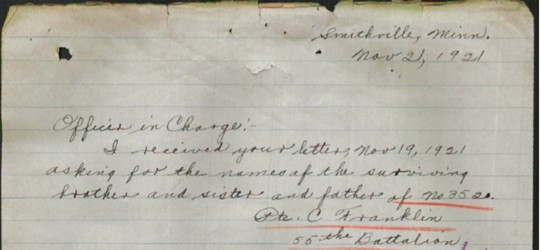

One last item to note is his place of birth. He used Montreal, Canada in his enlistment papers and indicated he was either a natural born British Subject or Naturalized British Subject. No information was found on his Canadian naturalization. Regardless of the accuracy of these statements, Charles WAS willing to commit 100%, and later with his life, to the Commonwealth cause.
Off to War
At 28 years old, Charles enlisted on 19 October 1915 at Holsworthy, New South Wales and was initially assigned to the 8th Reinforcements of the 19th Battalion. After a short period of military training, he boarded HMAT A35 Berrima on 17 December 1915, heading for Fremantle then on to Egypt. He arrived in Suez on 23 January 1916, but a few days later was sent to hospital at Heliopolis with severe gastritis. He was not discharged until 15 March. A month after re-joining his unit, he was reassigned to C Company of the recently formed 55th Battalion.
With the devastation of Gallipoli and the large influx of new recruits, major reorganizations had been underway. Half of the troops in the 55th were Gallipoli veterans from the 3rd Battalion and the other half were new recruits, mainly from New South Wales. They were stationed at Ferry Post, guarding the Suez Canal at the time Charles joined. On 19 June they began making preparations to move to Alexandria and on to the Western Front. They left Egypt on the Caledonia on 22 June, headed for Malta and then Marseilles.
They disembarked in France on 30 June and were immediately entrained for a three day trip, with the troops arriving in the camp at Thiennes at 2.30 AM. They were now just 30 km from Fleurbaix, but they got to see what they were fighting for.
Fromelles
This area near Fleurbaix was known as the “Nursery Sector” – a supposedly relatively quiet area where inexperienced Allied troops could learn the harsh realities of Western Front trench warfare against the Germans. But the quiet times and the training period did not last long.
Training intensified, including the use of gas masks and the exposure to the effects of heavy shelling and on 9 July they began a two day march towards the front. They were settled in the trenches for the first time at 1.00 AM on the 12th.
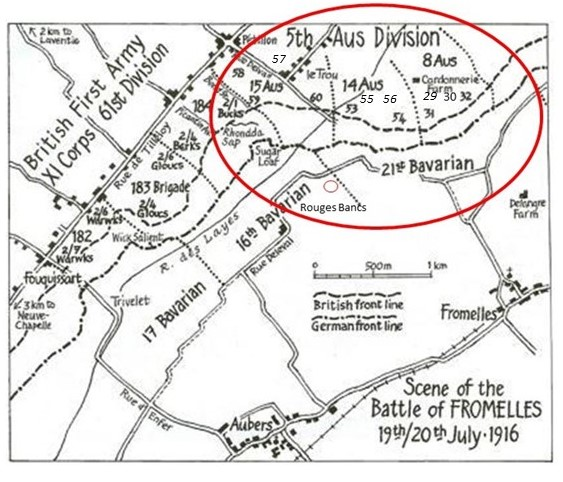
The 55th were carrying supplies on the 16th, readying for an attack the next day, but it was postponed due to the weather. Heavy bombardment was underway from both armies by 11 AM on the 19th and by 4 PM all were in position for the battle. The main objective for the 14th Brigade was to take the trenches to the left of a heavily armed, elevated German defensive position, the ‘Sugar Loaf’, which dominated the front lines. If the Sugar Loaf could not be taken, the Australians would be subjected to murderous enfilade fire from the machine guns and counterattacks from that direction.
As they advanced, they were to link up with the 31st and 60th Battalions. The 55th’s role was to provide support for the attacking 53rd and 54th Battalions by digging trenches and providing carrying parties for supplies and ammunition. They would be called in as the ‘third battalion’ if needed
Zero Hour for advancing from their front-line trenches was to be 5.45 PM on 19 July, but the Germans knew this attack was coming and were well-prepared. They opened a massive artillery bombardment on the Australians at 5.15 PM, causing chaos and many casualties. Immediately after the fighting started at 6.00 PM, the 55th went to work moving sandbags, ammunition and other supplies to support the early advances of the 53rd and 54th. The initial charges by the attacking battalions were successful, but at around 7:20 PM, Brigadier-General Elliott sent a report to Headquarters that the attack was failing and needed support.
In response, Major General McCay sent about 500 men forward and by 9:30 PM half of the ‘reserve’ 55th Battalion had joined into the battle to support the 53rd and 54th Battalions. With the reinforcements in place, the Australians were able to close gaps in the front lines. As they advanced, they found that their right flank was not protected by the 15th Brigade, who had not been able to progress due to the devastating defences at the Sugar Loaf. The 55th tried to shore up their flank defences, but:
“The Huns knew the country and trenches so perfectly that they succeeded time and again in bombing us back.”
The battle raged on with the Germans throwing many flares lighting up the lines and this was followed by bombs being thrown at the Australians. As the night wore on, the German counter attacks were able to expose their flanks.

With the pressure from the German advances by 4.00 AM the Australians were in retreat. Lieutenant Roy Goldrick of the 55th vividly describes the battle in a letter home:
“We all wish the war was over. I never shall forget the night of the 19th July, it was worse than hell! I have got to thank our Maker that I was not blown to pieces.
I got hit in seven places, first with a bullet from a machine gun, while crossing to 'No Man's Land,' but I was too excited to notice it. My mind was on leading my men, not of myself; death was nothing to me then!
We got into the Bosches' trenches and gave them a 'straffing' they will not forget. The bayonet did its deadly work. Anyway, they retired to their second line.
I was still going strong. Only about four officers reached the second line at this stage, so we decided to attack it. Over we went! I got there without a mark, but only two officers and about two hundred, men got over.
We bombed them out of the I second line, and they then retired to their third line. Only Captain Rawson myself, and about 130 men were left, but there were plenty of men coming up behind, so we decided to make a dash for the third line, and in doing so we suffered badly, only getting there with about seventy men. We bombed them out, and they retired to the flanks.
We remained there about half an hour, when I was hit in the arm and legs with bombs. Some were nasty smacks and were bleeding badly, but I did not take much notice of them, as we were in an awkward position.
All of a sudden I saw we were being gradually surrounded so we decided to retire. I got back to the second line with only seven men. All the rest were either killed or taken prisoners.”
For a battalion that was to be in reserve as the ‘third battalion’, the initial count at roll call was 42 killed or died of wounds, 154 wounded and 143 missing. Ultimately the impact was that 85 soldiers were killed or died from wounds.
Charles
As documented by his mate Francis Drum 4788, Charles had been in the advances that reached the German trenches. He was killed by a shell early in the morning of the 20th.
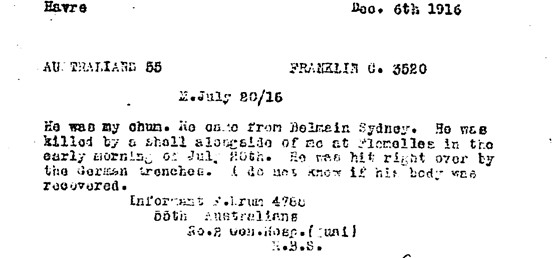
Charles’ body was not among those recovered after the battle and he was not identified from the extensive post-war searches for missing soldiers. He was awarded the British War Medal, the Victory Medal, a Memorial Scroll and a Memorial Plaque and these were sent to his parents in the US.
He is commemorated on Panel 13, VC Corner Australian Cemetery and Memorial, Fromelles and the Roll of Honour at the Australian War Memorial Panel 160.
News reached family in 1917 that Charles was killed in action.
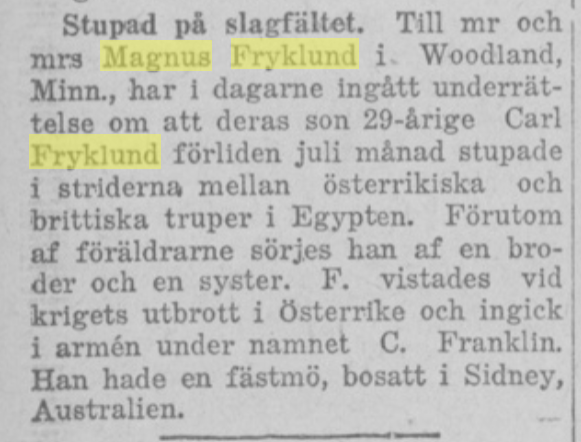
Mr. and Mrs. Magnus Fryklund in Woodland, Minnesota, notification has recently been received that their 29-year-old son Carl Fryklund fell in battle last July in the fighting between Austrian (sic) and British troops in Egypt (France). In addition to his parents, he is mourned by a brother and a sister. Fryklund was in Austria (sic) at the outbreak of the war and enlisted in the army under the name C. Franklin. He had a fiancée, residing in Sydney, Australia.
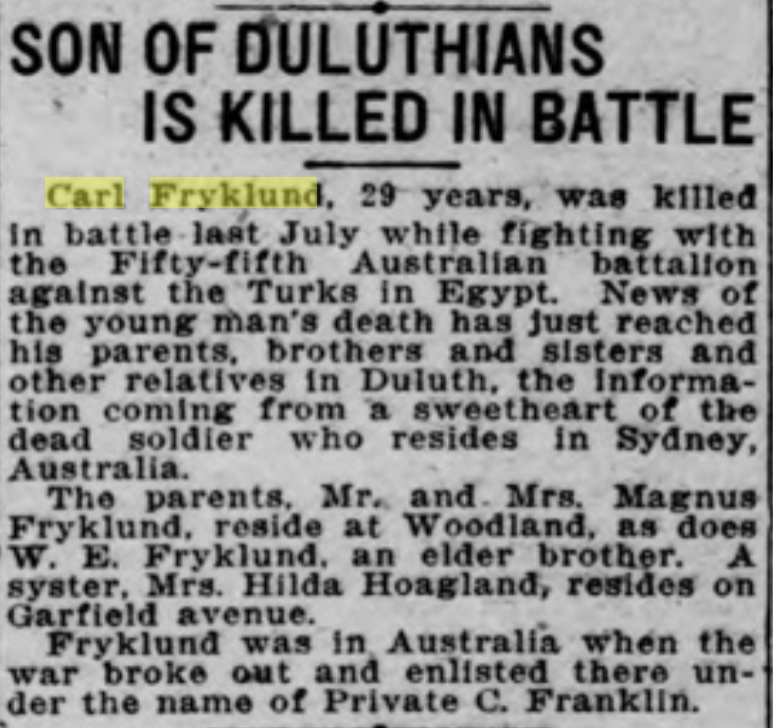
Charles may have been a foreigner, but he proved himself as a true Australian.
Could Charles Still Be Found?
After the battle, the Germans collected 250 soldiers who were later buried at Pheasant Wood. The 55th was fighting in the vicinity of the grave site and, as of 2024, 17 of the 46 unidentified soldiers from the 55th have been able to be identified by DNA matching from family members. They have been formally recognized in the Pheasant Wood Cemetery. A total of 180 soldiers have been identified. Charles could be one of the remaining 70 unidentified soldiers from the grave, but we are still searching for suitable family DNA donors. If you know anything of Charles’ contacts here in Australia or his relatives from Sweden or the USA, please contact the Fromelles Association.
DNA samples are being sought for family connections to
| Soldier | Karl Magnus Fryklund / Charles Franklin (1888 – 1916) |
| Parents | Magnus Magnusson Fryklund (1858-1929) Hudisk val, Gauleborg, Sweden and Emma Kristina Kangas Sjogren (1858-1929) Norrbotten, Sweden, both died Duluth MN USA |
| Siblings | Walfred Emmanuel (1986-1963) died Duluth, m Sofia Edson Stennabba (Finland) 2 sons USA | ||
| Hulda Maria (1887-1985), died St Louis MO USA, m John M Hoglund (Finland) 5 sons, 1 daughter | |||
| Oskar Gustaf Olaf (1890-1890) Sweden |
| Grandparents | |||
| Paternal | Magnus Jonsson (1824 – 1858), Sweden and Anna Cajsa Olsdr (1823 - ) Sweden | ||
| Maternal | Anders Johansson Kangas (1816 – 1886) Sweden and Maria Cajsa Isaksdottir (1820 – 1877) Sweden |
Seeking DNA Donors

Contacts
(Contact: carla@fromelles.info or geoffrey@fromelles.info).
(Contact: army.uwc@defence.gov.au or phone 1800 019 090).
Donations
If you are able, please contribute to the upkeep of this resource.
(Contact: bill@fromelles.info ).
